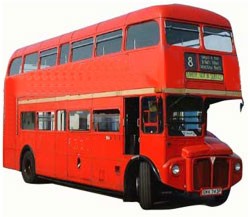Wayfarer-class Double-Deck Bus (TL6)
This article originally appeared in Freelance Traveller’s March 2012 issue.
 In particularly dense urban areas, before grav technology is
developed or can be imported, citizens need to get around. One form of
transport in common use and either publicly or privately owned is the
double-deck bus with cramped seating but the ability to carry large
numbers in a small space. The open platform at the rear instead of doors
allows speedy ingress and egress of passengers and indeed in slow moving
traffic it may not even be necessary to wait for the bus to actually
stop. The Wayfarer has 32 small double seats which can carry up to 64
seated but cramped passengers with 36 on the top deck and 28 on the
lower deck. There is insufficient headroom to stand easily except on the
rear platform. The upper deck is accessed by a narrow quarter spiral
staircase which may not be suitable for some patrons.
In particularly dense urban areas, before grav technology is
developed or can be imported, citizens need to get around. One form of
transport in common use and either publicly or privately owned is the
double-deck bus with cramped seating but the ability to carry large
numbers in a small space. The open platform at the rear instead of doors
allows speedy ingress and egress of passengers and indeed in slow moving
traffic it may not even be necessary to wait for the bus to actually
stop. The Wayfarer has 32 small double seats which can carry up to 64
seated but cramped passengers with 36 on the top deck and 28 on the
lower deck. There is insufficient headroom to stand easily except on the
rear platform. The upper deck is accessed by a narrow quarter spiral
staircase which may not be suitable for some patrons.
The driver sits in a cab behind and above the engine, completely separate from the passenger space such that there is no access without exiting the bus completely. Tickets are sold and checked by a conductor who also communicates via a bell system when all passengers have alighted or boarded so that the driver knows it is safe to move off. The same bell system can be utilized by the passengers to indicate that the bus should stop at the next bus stop – although in city centres particularly the bus may well be stopping at every stop in any case. There is very limited luggage space beneath the staircase at the rear and standing in this location is discouraged because of the open platform and the safety risk, but also because this is where the conductor naturally takes up position when not dealing with tickets. There is limited heating carried through to vents from the engine, but frequently more warmth is obtained from the press of bodies in the cramped seats.
Route indicators are situated on the front, rear and sides of the bus facilitating identifying vehicles from any angle. Typically these do not need to be changed often as a set of buses will service one route relatively exclusively.
Bus stops may be in use depending on culture, tradition or legal stipulations, but these buses are often in slow moving traffic or stopped at traffic signals and can be caught at any such point on a route. Again, depending on world or city, children may be carried free or have to purchase a (usually, reduced price) ticket. There are worlds which run such buses free to any passengers. Clustering of buses, say three arriving at a given point all at once, is a common sight in any city at this tech level and a couple beyond.
Typical dimensions: 8.4m x 2.4m x 4.4m (overall).
| Double-Deck Bus (TL6) | Volume (m3) | Mass (kg) | Cost (Cr) | |
|---|---|---|---|---|
| Hull | 90 m3 (base 75 m3) Box configuration, Light Alloys | - | 6,000.00 | 15,000 |
| Hull: 20 Structure: 21 | - | - | - | |
| Drive system | Ground, Wheels | 7.50 | 750.00 | 7,500 |
| Power Plant | Internal Combustion-6 Power output: 192 Fuel Consumption: 22/hour |
11.00 | 825.00 | 13,200 |
| Fuel | 220 liters (10 hours operation) | 0.22 | 220.00 | - |
| Armour | Light Alloys 2 | - | - | - |
| Sensors | Minimal (0.25, 0 DM) | 0.25 | 0.50 | 100 |
| Communications | N/A | - | - | - |
| Crew | 2 (1 driver, 1 conductor) | - | - | - |
| Operating stations | 1 | 1.25 | 125.00 | - |
| Passengers | 64 | 32.00 | 3,200.00 | - |
| Cargo | 0.21 Td | 2.78 | 278.00 | - |
| Agility | 0 | - | - | - |
| Speed | Cruise: 57 km/h Top: 76 km/h | - | - | - |
| TOTAL | 55.00 | 11,399.00 | 35,800 | |
| Ground Pressure | 1.51 | |||
 Freelance
Traveller
Freelance
Traveller